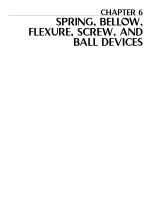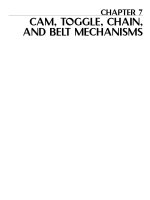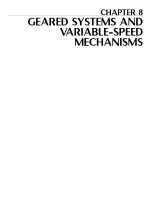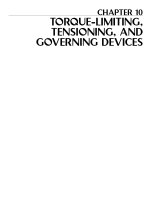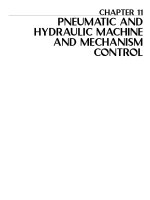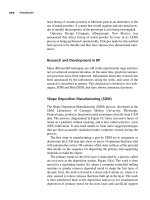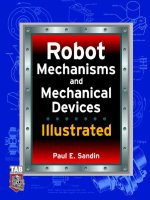mcgraw hill robot mechanisms and mechanical devices illustrated 2003 docx
Bạn đang xem bản rút gọn của tài liệu. Xem và tải ngay bản đầy đủ của tài liệu tại đây (6.48 MB, 337 trang )
Robot Mechanisms
and Mechanical
Devices Illustrated
Paul E. Sandin
McGraw-Hill
New York | Chicago | San Francisco | Lisbon | London | Madrid
Mexico City | Milan | New Delhi | San Juan | Seoul | Singapore | Sydney | Toronto
Copyright © 2003 by The McGraw-Hill Companies, Inc. All rights reserved. Manufactured in the United States of America.
Except as permitted under the United States Copyright Act of 1976, no part of this publication may be reproduced or distrib-
uted in any form or by any means, or stored in a database or retrieval system, without the prior written permission of the
publisher.
0-07-142928-X
The material in this eBook also appears in the print version of this title: 0-07-141200-X
All trademarks are trademarks of their respective owners. Rather than put a trademark symbol after every occurrence of a
trademarked name, we use names in an editorial fashion only, and to the benefit of the trademark owner, with no intention
of infringement of the trademark. Where such designations appear in this book, they have been printed with initial caps.
McGraw-Hill eBooks are available at special quantity discounts to use as premiums and sales promotions, or for use in cor-
porate training programs. For more information, please contact George Hoare, Special Sales, at george_hoare@mcgraw-
hill.com or (212) 904-4069.
TERMS OF USE
This is a copyrighted work and The McGraw-Hill Companies, Inc. (“McGraw-Hill”) and its licensors reserve all rights in
and to the work. Use of this work is subject to these terms. Except as permitted under the Copyright Act of 1976 and the
right to store and retrieve one copy of the work, you may not decompile, disassemble, reverse engineer, reproduce, modify,
create derivative works based upon, transmit, distribute, disseminate, sell, publish or sublicense the work or any part of it
without McGraw-Hill’s prior consent. You may use the work for your own noncommercial and personal use; any other use
of the work is strictly prohibited. Your right to use the work may be terminated if you fail to comply with these terms.
THE WORK IS PROVIDED “AS IS”. McGRAW-HILL AND ITS LICENSORS MAKE NO GUARANTEES OR WAR-
RANTIES AS TO THE ACCURACY, ADEQUACY OR COMPLETENESS OF OR RESULTS TO BE OBTAINED FROM
USING THE WORK, INCLUDING ANY INFORMATION THAT CAN BE ACCESSED THROUGH THE WORK VIA
HYPERLINK OR OTHERWISE, AND EXPRESSLY DISCLAIM ANY WARRANTY, EXPRESS OR IMPLIED,
INCLUDING BUT NOT LIMITED TO IMPLIED WARRANTIES OF MERCHANTABILITY OR FITNESS FOR A PAR-
TICULAR PURPOSE. McGraw-Hill and its licensors do not warrant or guarantee that the functions contained in the work
will meet your requirements or that its operation will be uninterrupted or error free. Neither McGraw-Hill nor its licensors
shall be liable to you or anyone else for any inaccuracy, error or omission, regardless of cause, in the work or for any dam-
ages resulting therefrom. McGraw-Hill has no responsibility for the content of any information accessed through the work.
Under no circumstances shall McGraw-Hill and/or its licensors be liable for any indirect, incidental, special, punitive, con-
sequential or similar damages that result from the use of or inability to use the work, even if any of them has been advised
of the possibility of such damages. This limitation of liability shall apply to any claim or cause whatsoever whether such
claim or cause arises in contract, tort or otherwise.
DOI: 10.1036/007142928X
ebook_copyright 8 x 10.qxd 8/27/03 9:17 AM Page 1
For Vicky, Conor, and Alex
This page intentionally left blank.
Contents
Introduction xi
Acknowledgments xxxv
Chapter 1 Motor and Motion Control Systems 1
Introduction 3
Merits of Electric Systems 4
Motion Control Classification 5
Closed-Loop System 5
Trapezoidal Velocity Profile 7
Closed-Loop Control Techniques 8
Open-Loop Motion Control Systems 9
Kinds of Controlled Motion 9
Motion Interpolation 10
Computer-Aided Emulation 10
Mechanical Components 11
Electronic System Components 15
Motor Selection 16
Motor Drivers (Amplifiers) 18
Feedback Sensors 19
Installation and Operation of the System 20
Servomotors, Stepper Motors, and Actuators for
Motion Control 20
Permanent-Magnet DC Servomotors 21
Brush-Type PM DC Servomotors 22
Disk-Type PM DC Motors 23
Cup- or Shell-Type PM DC Motors 24
Position Sensing in Brushless Motors 29
Brushless Motor Advantages 30
Brushless DC Motor Disadvantages 31
Characteristics of Brushless Rotary Servomotors 31
Linear Servomotors 31
v
For more information about this title, click here.
Copyright © 2003 by The McGraw-Hill Companies, Inc. Click here for Terms of Use.
vi Contents
Commutation 34
Installation of Linear Motors 35
Advantages of Linear vs. Rotary Servomotors 36
Coil Assembly Heat Dissipation 37
Stepper Motors 37
Permanent-Magnet (PM) Stepper Motors 38
Variable Reluctance Stepper Motors 38
Hybrid Stepper Motors 38
Stepper Motor Applications 40
DC and AC Motor Linear Actuators 41
Stepper-Motor Based Linear Actuators 42
Servosystem Feedback Sensors 43
Rotary Encoders 43
Incremental Encoders 44
Absolute Encoders 46
Linear Encoders 47
Magnetic Encoders 48
Resolvers 49
Tachometers 51
Linear Variable Differential Transformers (LVDTs) 53
Linear Velocity Transducers (LVTs) 55
Angular Displacement Transducers (ATDs) 55
Inductosyns 57
Laser Interferometers 57
Precision Multiturn Potentiometers 59
Solenoids and Their Applications 60
Solenoids: An Economical Choice for Linear or Rotary Motion 60
Technical Considerations 62
Open-Frame Solenoids 63
C-Frame Solenoids 63
Box-Frame Solenoids 63
Tubular Solenoids 64
Rotary Solenoids 64
Rotary Actuators 66
Actuator Count 67
Debugging 67
Reliability 68
Cost 68
Chapter 2 Indirect Power Transfer Devices 69
Belts 72
Contents vii
Flat Belts 73
O-Ring Belts 73
V-Belts 73
Timing Belts 75
Smoother Drive Without Gears 76
Plastic-and-Cable Chain 77
Chain 79
Ladder Chain 80
Roller Chain 80
Rack and Pinion Chain Drive 82
Timing or Silent Chain 82
Friction Drives 83
Cone Drive Needs No Gears Or Pulleys 84
Gears 85
Gear Terminology 87
Gear Dynamics Terminology 88
Gear Classification 88
Worm Gears 90
Worm Gear with Hydrostatic Engagement 90
Controlled Differential Drives 93
Twin-Motor Planetary Gears Provide Safety Plus Dual-Speed 95
Harmonic-Drive Speed Reducers 96
Advantages and Disadvantages 99
Flexible Face-Gears Make Efficient High-Reduction Drives 100
High-Speed Gearheads Improve Small Servo Performance 102
Simplify the Mounting 102
Cost-Effective Addition 104
Chapter 3 Direct Power Transfer Devices 107
Couplings 109
Methods for Coupling Rotating Shafts 110
Ten Universal Shaft Couplings 114
Hooke’s Joints 114
Constant-Velocity Couplings 115
Coupling of Parallel Shafts 117
Ten Different Splined Connections 118
Cylindrical Splines 118
Face Splines 120
Torque Limiters 121
Ten Torque-Limiters 121
One Time Use Torque Limiting 125
viii Contents
Chapter 4 Wheeled Vehicle Suspensions and Drivetrains 127
Wheeled Mobility Systems 130
Why Not Springs? 130
Shifting the Center of Gravity 131
Wheel Size 134
Three-Wheeled Layouts 136
Four-Wheeled Layouts 141
All-Terrain Vehicle with Self-Righting and Pose Control 144
Six-Wheeled Layouts 150
Eight-Wheeled Layouts 155
Chapter 5 Tracked Vehicle Suspensions and Drive Trains 161
Steering Tracked Vehicles 167
Various Track Construction Methods 168
Track Shapes 171
Track Suspension Systems 174
Track System Layouts 178
One-Track Drive Train 178
Two-Tracked Drive Trains 179
Two-Tracked Drive Trains with Separate Steering Systems 180
Four-Tracked Drive Trains 181
Six-Tracked Drive Trains 184
Chapter 6 Steering History 187
Steering Basics 190
The Next Step Up 193
Chapter 7 Walkers 199
Leg Actuators 202
Leg Geometries 203
Walking Techniques 208
Wave Walking 208
Independent Leg Walking 208
Frame Walking 211
Roller-Walkers 214
Flexible Legs 214
Contents ix
Chapter 8 Pipe Crawlers and Other Special Cases 217
Horizontal Crawlers 220
Vertical Crawlers 221
Traction Techniques for Vertical Pipe Crawlers 222
Wheeled Vertical Pipe Crawlers 223
Tracked Crawlers 224
Other Pipe Crawlers 224
External Pipe Vehicles 226
Snakes 226
Chapter 9 Comparing Locomotion Methods 227
What Is Mobility? 229
The Mobility System 229
Size 230
Efficiency 231
The Environment 232
Thermal 232
Ground Cover 233
Topography 233
Obstacles 234
Complexity 235
Speed and Cost 235
The Mobility Index Comparison Method 236
The Practical Method 236
Explain All This Using the Algebraic Method 237
Chapter 10 Manipulator Geometries 239
Positioning, Orienting, How Many Degrees of Freedom? 241
E-Chain 243
Slider Crank 243
Arm Geometries 245
Cartesian or Rectangular 246
Cylindrical 247
Polar or Spherical 248
The Wrist 250
Grippers 252
Passive Parallel Jaw Using Cross Tie 255
Passive Capture Joint with Three Degrees of Freedom 256
x Contents
Industrial Robots 258
Industrial Robot Advantages 259
Trends in Industrial Robots 259
Industrial Robot Characteristics 261
Chapter 11 Proprioceptive and Environmental Sensing
Mechanisms and Devices
263
Industrial Limit Switches 270
Layouts 276
Combination Trip (Sense) and Hard Stop 277
By-Pass Layouts 278
Reversed Bump 279
Bumper Geometries and Suspensions 280
Simple Bumper Suspension Devices 282
Three Link Planar 283
Tension Spring Star 284
Torsion Swing Arm 284
Horizontal Loose Footed Leaf Spring 285
Sliding Front Pivot 286
Suspension Devices to Detect Motions in All Three Planes 287
Conclusion 289
Index 291
Introduction
T
his book is meant to be interesting, helpful, and educational to hob-
byists, students, educators, and midlevel engineers studying or
designing mobile robots that do real work. It is primarily focused on
mechanisms and devices that relate to vehicles that move around by
themselves and actually do things autonomously, i.e. a robot. Making a
vehicle that can autonomously drive around, both indoors and out,
seems, at first, like a simple thing. Build a chassis, add drive wheels,
steering wheels, a power source (usually batteries), some control code
that includes some navigation and obstacle avoidance routines or some
other way to control it, throw some bump sensors on it, and presto! a
robot.
Unfortunately, soon after these first attempts, the designer will find
the robot getting stuck on what seem to be innocuous objects or bumps,
held captive under a chair or fallen tree trunk, incapable of doing any-
thing useful, or with a manipulator that crushes every beer can it tries to
pick up. Knowledge of the mechanics of sensors, manipulators, and the
concept of mobility will help reduce these problems. This book provides
that knowledge with the aid of hundreds of sketches showing drive lay-
outs and manipulator geometries and their work envelope. It discusses
what mobility really is and how to increase it without increasing the size
of the robot, and how the shape of the robot can have a dramatic effect on
its performance. Interspersed throughout the book are unusual mecha-
nisms and devices, included to entice the reader to think outside the box.
It is my sincere hope that this book will decrease the time it takes to pro-
duce a working robot, reduce the struggles and effort required to achieve
that goal, and, therefore, increase the likelihood that your project will be
a success.
Building, designing, and working with practical mobile robots
requires knowledge in three major engineering fields: mechanical, elec-
trical, and software. Many books have been written on robots, some
focusing on the complete robot system, others giving a cookbook
approach allowing a novice to take segments of chapters and put together
xi
Copyright © 2003 by The McGraw-Hill Companies, Inc. Click here for Terms of Use.
xii Introduction
a unique robot. While there are books describing the electric circuits
used in robots, and books that teach the software and control code for
robots, there are few that are focused entirely on the mechanisms and
mechanical devices used in mobile robots.
This book intends to fill the gap in the literature of mobile robots by
containing, in a single reference, complete graphically presented infor-
mation on the mechanics of a mobile robot. It is written in laymen’s lan-
guage and filled with sketches so novices and those not trained in
mechanical engineering can acquire some understanding of this interest-
ing field. It also includes clever schemes and mechanisms that mid-level
mechanical engineers should find new and useful. Since mobile robots
are being called on to perform more and more complex and practical
tasks, and many are now carrying one or even two manipulators, this
book has a section on manipulators and grippers for mobile robots. It
shows why a manipulator used on a robot is different in several ways
from a manipulator used in industry.
Autonomous robots place special demands on their mobility system
because of the unstructured and highly varied environment the robot
might drive through, and the fact that even the best sensors are poor in
comparison to a human’s ability to see, feel, and balance. This means the
mobility system of a robot that relies on those sensors will have much
less information about the environment and will encounter obstacles that
it must deal with on its own. In many cases, the microprocessor control-
ling the robot will only be telling the mobility system “go over there”
without regard to what lays directly in that path. This forces the mobility
system to be able to handle anything that comes along.
In contrast, a human driver has very acute sensors: eyes for seeing
things and ranging distances, force sensors to sense acceleration, and
balance to sense levelness. A human expects certain things of an auto-
mobile’s (car, truck, jeep, HumVee, etc.) mobility system (wheels, sus-
pension, and steering) and uses those many and powerful sensors to
guide that mobility system’s efforts to traverse difficult terrain. The
robot’s mobility system must be passively very capable, the car’s mobil-
ity system must feel right to a human.
For these reasons, mobility systems on mobile robots can be both sim-
pler and more complex than those found in automobiles. For example,
the Ackerman steering system in automobiles is not actually suited for
high mobility. It feels right to a human, and it is well suited to higher
speed travel, but a robot doesn’t care about feeling right, not yet, at least!
The best mobility system for a robot to have is one that effectively
accomplishes the required task, without regard to how well a human
could use it.
Introduction xiii
There are a few terms specific to mobile robots that must be defined to
avoid confusion. First, the term robot itself has unfortunately come to
have at least three different meanings. In this book, the word robot
means an autonomous or semi-autonomous mobile land vehicle that may
or may not have a manipulator or other device for affecting its environ-
ment. Colin Angle, CEO of iRobot Corp. defines a robot as a mobile
thing with sensors that looks at those sensors and decides on its own
what actions to take.
In the manufacturing industry, however, the word robot means a
reprogrammable stationary manipulator with few, if any sensors, com-
monly found in large industrial manufacturing plants. The third common
meaning of robot is a teleoperated vehicle similar to but more sophisti-
cated than a radio controlled toy car or truck. This form of robot usually
has a microprocessor on it to aid in controlling the vehicle itself, perform
some autonomous or automatic tasks, and aid in controlling the manipu-
lator if one is onboard.
This book mainly uses the first meaning of robot and focuses on
things useful to making robots, but it also includes several references to
mechanisms useful to both of the other types of robots. Robot and
mobile robot are used interchangeably throughout the book.
Autonomous, in this book, means acting completely independent of any
human input. Therefore, autonomous robot means a self-controlled, self-
powered, mobile vehicle that makes its own decisions based on inputs
from sensors. There are very few truly autonomous robots, and no
known autonomous robots with manipulators on them whose manipula-
tors are also autonomous. The more common form of mobile robot today
is semiautonomous, where the robot has some sensors and acts partially
on its own, but there is always a human in the control loop through a
radio link or tether. Another name for this type of control structure is
telerobotic, as opposed to a teleoperated robot, where there are no, or
very few, sensors on the vehicle that it uses to make decisions. Specific
vehicles in this book that do not use sensors to make decisions are
labeled telerobotic or teleoperated to differentiate them from
autonomous robots. It is important to note that the mechanisms and
mechanical devices that are shown in this book can be applied, in their
appropriate category, to almost any vehicle or manipulator whether
autonomous or not.
Another word, which gets a lot of use in the robot world, is mobility.
Mobility is defined in this book as a drive system’s ability to deal with
the effects of heat and ice, ground cover, slopes or staircases, and to
negotiate obstacles. Chapter Nine focuses entirely on comparing drive
systems’ mobility based on a wide range of common obstacles found in
xiv Introduction
outdoor and indoor environments, some of which can be any size (like
rocks), others that cannot (like stair cases).
I intentionally left out the whole world of hydraulics. While
hydraulic power can be the answer when very compact actuators or
high power density motors are required, it is potentially more danger-
ous, and definitely messier, to work with than electrically powered
devices. It is also much less efficient—a real problem for battery pow-
ered robots. There are many texts on hydraulic power and its uses. If
hydraulics is being considered in a design, the reader is referred to Industrial
Fluid Power (4 volumes) 3rd ed., published by Womack Education
Publications.
The designer has powerful tools to aid in the design process beyond
the many tricks, mechanical devices, and techniques shown in this book.
These tools include 3D design tools like SolidWorks and Pro-Engineer
and also new ways to produce prototypes of the mechanisms themselves.
This is commonly called Rapid Prototyping (RP).
NEW PROCESSES EXPAND CHOICES
FOR RAPID PROTOTYPING
New concepts in rapid prototyping (RP) have made it possible to build
many different kinds of 3D prototype models faster and cheaper than by
traditional methods. The 3D models are fashioned automatically from
such materials as plastic or paper, and they can be full size or scaled-
down versions of larger objects. Rapid-prototyping techniques make use
of computer programs derived from computer-aided design (CAD)
drawings of the object. The completed models, like those made by
machines and manual wood carving, make it easier for people to visual-
ize a new or redesigned product. They can be passed around a conference
table and will be especially valuable during discussions among product
design team members, manufacturing managers, prospective suppliers,
and customers.
At least nine different RP techniques are now available commercially,
and others are still in the development stage. Rapid prototyping models
can be made by the owners of proprietary equipment, or the work can be
contracted out to various RP centers, some of which are owned by the RP
equipment manufacturers. The selection of the most appropriate RP
method for any given modeling application usually depends on the
urgency of the design project, the relative costs of each RP process, and
Introduction xv
the anticipated time and cost savings RP will offer over conventional
model-making practice. New and improved RP methods are being intro-
duced regularly, so the RP field is in a state of change, expanding the
range of designer choices.
Three-dimensional models can be made accurately enough by RP
methods to evaluate the design process and eliminate interference fits or
dimensioning errors before production tooling is ordered. If design flaws
or omissions are discovered, changes can be made in the source CAD
program and a replacement model can be produced quickly to verify that
the corrections or improvements have been made. Finished models are
useful in evaluations of the form, fit, and function of the product design
and for organizing the necessary tooling, manufacturing, or even casting
processes.
Most of the RP technologies are additive; that is, the model is made
automatically by building up contoured laminations sequentially from
materials such as photopolymers, extruded or beaded plastic, and even
paper until they reach the desired height. These processes can be used to
form internal cavities, overhangs, and complex convoluted geometries as
well as simple planar or curved shapes. By contrast, a subtractive RP
process involves milling the model from a block of soft material, typi-
cally plastic or aluminum, on a computer-controlled milling machine
with commands from a CAD-derived program.
In the additive RP processes, photopolymer systems are based on suc-
cessively depositing thin layers of a liquid resin, which are then solidi-
fied by exposure to a specific wavelengths of light. Thermoplastic sys-
tems are based on procedures for successively melting and fusing solid
filaments or beads of wax or plastic in layers, which harden in the air to
form the finished object. Some systems form layers by applying adhe-
sives or binders to materials such as paper, plastic powder, or coated
ceramic beads to bond them.
The first commercial RP process introduced was stereolithography in
1987, followed by a succession of others. Most of the commercial RP
processes are now available in Europe and Japan as well as the United
States. They have become multinational businesses through branch
offices, affiliates, and franchises.
Each of the RP processes focuses on specific market segments, taking
into account their requirements for model size, durability, fabrication
speed, and finish in the light of anticipated economic benefits and cost.
Some processes are not effective in making large models, and each
process results in a model with a different finish. This introduces an eco-
nomic tradeoff of higher price for smoother surfaces versus additional
cost and labor of manual or machine finishing by sanding or polishing.
xvi Introduction
Rapid prototyping is now also seen as an integral part of the even
larger but not well defined rapid tooling (RT) market. Concept modeling
addresses the early stages of the design process, whereas RT concen-
trates on production tooling or mold making.
Some concept modeling equipment, also called 3D or office printers,
are self-contained desktop or benchtop manufacturing units small
enough and inexpensive enough to permit prototype fabrication to be
done in an office environment. These units include provision for the con-
tainment or venting of any smoke or noxious chemical vapors that will
be released during the model’s fabrication.
Computer-Aided Design Preparation
The RP process begins when the object is drawn on the screen of a CAD
workstation or personal computer to provide the digital data base. Then,
in a post-design data processing step, computer software slices the object
mathematically into a finite number of horizontal layers in generating an
STL (Solid Transfer Language) file. The thickness of the “slices” can
range from 0.0025 to 0.5 in. (0.06 to 13 mm) depending on the RP
process selected. The STL file is then converted to a file that is compati-
ble with the specific 3D “printer” or processor that will construct the
model.
The digitized data then guides a laser, X-Y table, optics, or other
apparatus that actually builds the model in a process comparable to
building a high-rise building one story at a time. Slice thickness might
have to be modified in some RP processes during model building to
compensate for material shrinkage.
Prototyping Choices
All of the commercial RP methods depend on computers, but four of
them depend on laser beams to cut or fuse each lamination, or provide
enough heat to sinter or melt certain kinds of materials. The four
processes that make use of lasers are Directed-Light Fabrication (DLF),
Laminated-Object Manufacturing (LOM), Selective Laser Sintering
(SLS), and Stereolithography (SL); the five processes that do not require
lasers are Ballistic Particle Manufacturing (BPM), Direct-Shell
Production Casting (DSPC), Fused-Deposition Modeling (FDM), Solid-
Ground Curing (SGC), and 3D Printing (3DP).
Introduction xvii
Stereolithography (SL)
The stereolithographic (SL) process is performed on the equipment
shown in Figure 1. The movable platform on which the 3D model is
formed is initially immersed in a vat of liquid photopolymer resin to a
level just below its surface so that a thin layer of the resin covers it. The
SL equipment is located in a sealed chamber to prevent the escape of
fumes from the resin vat.
The resin changes from a liquid to a solid when exposed to the ultra-
violet (UV) light from a low-power, highly focused laser. The UV laser
beam is focused on an X-Y mirror in a computer-controlled beam-shap-
ing and scanning system so that it draws the outline of the lowest cross-
section layer of the object being built on the film of photopolymer resin.
After the first layer is completely traced, the laser is then directed to
scan the traced areas of resin to solidify the model’s first cross section.
The laser beam can harden the layer down to a depth of 0.0025 to 0.0300
in. (0.06 to 0.8 mm). The laser beam scans at speeds up to 350 in./s (890
cm/s). The photopolymer not scanned by the laser beam remains a liq-
uid. In general, the thinner the resin film (slice thickness), the higher the
resolution or more refined the finish of the completed model. When
model surface finish is important, layer thicknesses are set for 0.0050 in.
(0.13 mm) or less.
The table is then submerged under computer control to the specified
depth so that the next layer of liquid polymer flows over the first hard-
ened layer. The tracing, hardening, and recoating steps are repeated,
layer-by-layer, until the complete 3D model is built on the platform
within the resin vat.
Figure 1 Stereolithography (SL):
A computer-controlled
neon–helium ultraviolet light
(UV)–emitting laser outlines each
layer of a 3D model in a thin liq-
uid film of UV-curable photopoly-
mer on a platform submerged a
vat of the resin. The laser then
scans the outlined area to solidify
the layer, or “slice.” The platform
is then lowered into the liquid to
a depth equal to layer thickness,
and the process is repeated for
each layer until the 3D model is
complete. Photopolymer not
exposed to UV remains liquid.
The model is them removed for
finishing.
xviii Introduction
Because the photopolymer used in the SL process tends to curl or sag
as it cures, models with overhangs or unsupported horizontal sections
must be reinforced with supporting structures: walls, gussets, or
columns. Without support, parts of the model can sag or break off before
the polymer has fully set. Provision for forming these supports is
included in the digitized fabrication data. Each scan of the laser forms
support layers where necessary while forming the layers of the model.
When model fabrication is complete, it is raised from the polymer vat
and resin is allowed to drain off; any excess can be removed manually
from the model’s surfaces. The SL process leaves the model only par-
tially polymerized, with only about half of its fully cured strength. The
model is then finally cured by exposing it to intense UV light in the
enclosed chamber of post-curing apparatus (PCA). The UV completes
the hardening or curing of the liquid polymer by linking its molecules in
chainlike formations. As a final step, any supports that were required are
removed, and the model’s surfaces are sanded or polished. Polymers
such as urethane acrylate resins can be milled, drilled, bored, and tapped,
and their outer surfaces can be polished, painted, or coated with sprayed-
on metal.
The liquid SL photopolymers are similar to the photosensitive UV-
curable polymers used to form masks on semiconductor wafers for etch-
ing and plating features on integrated circuits. Resins can be formulated
to solidify under either UV or visible light.
The SL process was the first to gain commercial acceptance, and it
still accounts for the largest base of installed RP systems. 3D Systems of
Valencia, California, is a company that manufactures stereolithography
equipment for its proprietary SLA process. It offers the ThermoJet Solid
Object Printer. The SLA process can build a model within a volume
measuring 10 × 7.5 × 8 in. (25 × 19 × 20 cm). It also offers the SLA 7000
system, which can form objects within a volume of 20 × 20 × 23.62 in.
(51 × 51 × 60 cm). Aaroflex, Inc. of Fairfax, Virginia, manufactures the
Aacura 22 solid-state SL system and operates AIM, an RP manufactur-
ing service.
Solid Ground Curing (SGC)
Solid ground curing (SGC) (or the “solider process”) is a multistep in-
line process that is diagrammed in Figure 2. It begins when a photomask
for the first layer of the 3D model is generated by the equipment shown
at the far left. An electron gun writes a charge pattern of the photomask
on a clear glass plate, and opaque toner is transferred electrostatically to
the plate to form the photolithographic pattern in a xerographic process.
Introduction xix
The photomask is then moved to the exposure station, where it is aligned
over a work platform and under a collimated UV lamp.
Model building begins when the work platform is moved to the right
to a resin application station where a thin layer of photopolymer resin is
applied to the top surface of the work platform and wiped to the desired
thickness. The platform is then moved left to the exposure station, where
the UV lamp is then turned on and a shutter is opened for a few seconds
to expose the resin layer to the mask pattern. Because the UV light is so
intense, the layer is fully cured and no secondary curing is needed.
The platform is then moved back to the right to the wiper station,
where all of resin that was not exposed to UV is removed and discarded.
The platform then moves right again to the wax application station,
where melted wax is applied and spread into the cavities left by the
removal of the uncured resin. The wax is hardened at the next station by
pressing it against a cooling plate. After that, the platform is moved right
again to the milling station, where the resin and wax layer are milled to a
precise thickness. The platform piece is then returned to the resin appli-
cation station, where it is lowered a depth equal to the thickness of the
next layer and more resin is applied.
Figure 2 Solid Ground Curing (SGC): First, a photomask is generated on a glass plate by
a xerographic process. Liquid photopolymer is applied to the work platform to form a
layer, and the platform is moved under the photomask and a strong UV source that
defines and hardens the layer. The platform then moves to a station for excess polymer
removal before wax is applied over the hardened layer to fill in margins and spaces. After
the wax is cooled, excess polymer and wax are milled off to form the first “slice.” The first
photomask is erased, and a second mask is formed on the same glass plate. Masking and
layer formation are repeated with the platform being lowered and moved back and forth
under the stations until the 3D model is complete. The wax is then removed by heating
or immersion in a hot water bath to release the prototype.
xx Introduction
Meanwhile, the opaque toner has been removed from the glass mask
and a new mask for the next layer is generated on the same plate. The
complete cycle is repeated, and this will continue until the 3D model
encased in the wax matrix is completed. This matrix supports any over-
hangs or undercuts, so extra support structures are not needed.
After the prototype is removed from the process equipment, the wax is
either melted away or dissolved in a washing chamber similar to a dish-
washer. The surface of the 3D model is then sanded or polished by other
methods.
The SGC process is similar to drop on demand inkjet plotting, a
method that relies on a dual inkjet subsystem that travels on a precision
X-Y drive carriage and deposits both thermoplastic and wax materials
onto the build platform under CAD program control. The drive carriage
also energizes a flatbed milling subsystem for obtaining the precise ver-
tical height of each layer and the overall object by milling off the excess
material.
Cubital America Inc., Troy, Michigan, offers the Solider 4600/5600
equipment for building prototypes with the SGC process.
Selective Laser Sintering (SLS)
Selective laser sintering (SLS) is another RP process similar to stere-
olithography (SL). It creates 3D models from plastic, metal, or ceramic
powders with heat generated by a carbon dioxide infrared (IR)–emitting
laser, as shown in Figure 3. The prototype is fabricated in a cylinder with
a piston, which acts as a moving platform, and it is positioned next to a
cylinder filled with preheated powder. A piston within the powder deliv-
ery system rises to eject powder, which is spread by a roller over the top
of the build cylinder. Just before it is applied, the powder is heated fur-
ther until its temperature is just below its melting point
When the laser beam scans the thin layer of powder under the control
of the optical scanner system, it raises the temperature of the powder
even further until it melts or sinters and flows together to form a solid
layer in a pattern obtained from the CAD data.
As in other RP processes, the piston or supporting platform is lowered
upon completion of each layer and the roller spreads the next layer of
powder over the previously deposited layer. The process is repeated, with
each layer being fused to the underlying layer, until the 3D prototype is
completed.
The unsintered powder is brushed away and the part removed. No
final curing is required, but because the objects are sintered they are
porous. Wax, for example, can be applied to the inner and outer porous
Introduction xxi
surfaces, and it can be smoothed by various manual or machine grinding
or melting processes. No supports are required in SLS because over-
hangs and undercuts are supported by the compressed unfused powder
within the build cylinder.
Many different powdered materials have been used in the SLS
process, including polycarbonate, nylon, and investment casting wax.
Polymer-coated metal powder is also being studied as an alternative. One
advantage of the SLS process is that materials such as polycarbonate and
nylon are strong and stable enough to permit the model to be used in lim-
ited functional and environmental testing. The prototypes can also serve
as molds or patterns for casting parts.
SLS process equipment is enclosed in a nitrogen-filled chamber that is
sealed and maintained at a temperature just below the melting point of
the powder. The nitrogen prevents an explosion that could be caused by
the rapid oxidation of the powder.
The SLS process was developed at the University of Texas at Austin,
and it has been licensed by the DTM Corporation of Austin, Texas. The
company makes a Sinterstation 2500plus. Another company participat-
ing in SLS is EOS GmbH of Germany.
Figure 3 Selective Laser Sintering (SLS): Loose plastic powder from a reservoir is distrib-
uted by roller over the surface of piston in a build cylinder positioned at a depth below
the table equal to the thickness of a single layer. The powder layer is then scanned by a
computer-controlled carbon dioxide infrared laser that defines the layer and melts the
powder to solidify it. The cylinder is again lowered, more powder is added, and the
process is repeated so that each new layer bonds to the previous one until the 3D model
is completed. It is then removed and finished. All unbonded plastic powder can be
reused.
xxii Introduction
Laminated-Object Manufacturing (LOM)
The Laminated-Object Manufacturing (LOM) process, diagrammed in
Figure 4, forms 3D models by cutting, stacking, and bonding successive
layers of paper coated with heat-activated adhesive. The carbon-dioxide
laser beam, directed by an optical system under CAD data control, cuts
cross-sectional outlines of the prototype in the layers of paper, which are
bonded to previous layers to become the prototype.
The paper that forms the bottom layer is unwound from a supply roll
and pulled across the movable platform. The laser beam cuts the outline
of each lamination and cross-hatches the waste material within and
around the lamination to make it easier to remove after the prototype is
completed. The outer waste material web from each lamination is con-
tinuously removed by a take-up roll. Finally, a heated roller applies pres-
sure to bond the adhesive coating on each layer cut from the paper to the
previous layer.
A new layer of paper is then pulled from a roll into position over the
previous layer, and the cutting, cross hatching, web removal, and bond-
ing procedure is repeated until the model is completed. When all the lay-
ers have been cut and bonded, the excess cross-hatched material in the
Figure 4 Laminated Object Manufacturing (LOM): Adhesive-backed paper is fed across
an elevator platform and a computer-controlled carbon dioxide infrared-emitting laser
cuts the outline of a layer of the 3D model and cross-hatches the unused paper. As more
paper is fed across the first layer, the laser cuts the outline and a heated roller bonds the
adhesive of the second layer to the first layer. When all the layers have been cut and
bonded, the cross-hatched material is removed to expose the finished model. The com-
plete model can then be sealed and finished.
Introduction xxiii
form of stacked segments is removed to reveal the finished 3D model.
The models made by the LOM have woodlike finishes that can be sanded
or polished before being sealed and painted.
Using inexpensive, solid-sheet materials makes the 3D LOM models
more resistant to deformity and less expensive to produce than models
made by other processes, its developers say. These models can be used
directly as patterns for investment and sand casting, and as forms for sil-
icone molds. The objects made by LOM can be larger than those made
by most other RP processes—up to 30 × 20 × 20 in. (75 × 50 × 50 cm).
The LOM process is limited by the ability of the laser to cut through
the generally thicker lamination materials and the additional work that
must be done to seal and finish the model’s inner and outer surfaces.
Moreover, the laser cutting process burns the paper, forming smoke that
must be removed from the equipment and room where the LOM process
is performed.
Helysys Corporation, Torrance, California, manufactures the LOM-
2030H LOM equipment. Alternatives to paper including sheet plastic
and ceramic and metal-powder-coated tapes have been developed.
Other companies offering equipment for building prototypes from
paper laminations are the Schroff Development Corporation, Mission,
Kansas, and CAM-LEM, Inc. Schroff manufactures the JP System 5 to
permit desktop rapid prototyping.
Fused Deposition Modeling (FDM)
The Fused Deposition Modeling (FDM) process, diagrammed in Figure 5,
forms prototypes from melted thermoplastic filament. This filament,
with a diameter of 0.070 in. (1.78 mm), is fed into a temperature-
controlled FDM extrusion head where it is heated to a semi-liquid state.
It is then extruded and deposited in ultrathin, precise layers on a fixture-
less platform under X-Y computer control. Successive laminations rang-
ing in thickness from 0.002 to 0.030 in. (0.05 to 0.76 mm) with wall
thicknesses of 0.010 to 0.125 in. (0.25 to 3.1 mm) adhere to each by ther-
mal fusion to form the 3D model.
Structures needed to support overhanging or fragile structures in FDM
modeling must be designed into the CAD data file and fabricated as part
of the model. These supports can easily be removed in a later secondary
operation.
All components of FDM systems are contained within temperature-
controlled enclosures. Four different kinds of inert, nontoxic filament
materials are being used in FDM: ABS polymer (acrylonitrile butadiene
styrene), high-impact-strength ABS (ABSi), investment casting wax, and
xxiv Introduction
elastomer. These materials melt at temperatures between 180 and 220ºF
(82 and 104ºC).
FDM is a proprietary process developed by Stratasys, Eden Prairie,
Minnesota. The company offers four different systems. Its Genisys
benchtop 3D printer has a build volume as large as 8 × 8 × 8 in. (20 × 20
× 20 cm), and it prints models from square polyester wafers that are
stacked in cassettes. The material is heated and extruded through a 0.01-
in. (0.25-mm)–diameter hole at a controlled rate. The models are built on
a metallic substrate that rests on a table. Stratasys also offers four sys-
tems that use spooled material. The FDM2000, another benchtop sys-
tem, builds parts up to 10 in
3
(164 cm
3
) while the FDM3000, a floor-
standing system, builds parts up to 10 × 10 × 16 in. (26 × 26 × 41 cm).
Two other floor-standing systems are the FDM 8000, which builds
models up to 18 × 18 × 24 in. (46 × 46 × 61 cm), and the FDM Quantum
system, which builds models up to 24 × 20 × 24 in. (61 × 51 × 61 cm).
All of these systems can be used in an office environment.
Stratasys offers two options for forming and removing supports: a
breakaway support system and a water-soluble support system. The
Figure 5 Fused Deposition Modeling (FDM): Filaments of thermoplastic are unwound
from a spool, passed through a heated extrusion nozzle mounted on a computer-
controlled X-Y table, and deposited on the fixtureless platform. The 3D model is formed
as the nozzle extruding the heated filament is moved over the platform. The hot filament
bonds to the layer below it and hardens. This laserless process can be used to form thin-
walled, contoured objects for use as concept models or molds for investment casting. The
completed object is removed and smoothed to improve its finish.
